Cycloheximide
Produced by the bacterium Streptomyces griseus, Cycloheximide is a glutarimide antibiotic, occupying a unique space in the scientific tool box due to its antifungal properties and potential role in the inhibition of protein synthesis. It is rendered as a crucial tool for researchers delving into diversified areas of cellular and molecular biology as cycloheximide has revolutionised the fields by targeting the ribosomal machinery accountable for protein synthesis. The capability of cycloheximide to inhibit protein synthesis has reckoned it as a valuable tool in various fields of study, perfectly capturing the attention of researchers from comprehending basic cellular processes to undergoing development of novel drugs. This blog embarks on the journey to unveil history, mechanism of action and diverse applications of cycloheximide by delving into its significance in the realm of modern scientific exploration and shedding light on its impact, properties and toxic effects.
Cycloheximide, appearing as colorless crystals is a 4-(2-hydroxyethyl)piperidine-2,6-dione in which the replacing of hydrogens attached to the carbon bearing the hydroxyl group by a 3,5-dimethyl-2-oxocyclohexyl group is investigated in its structure with the molecular weight of 281.35 g/mol being functionally inclined to piperidine-2,6-dione. With the molecular formula of C15H23NO4, Cucloheximide is a member of piperidones, a piperidine antibiotic, an antibiotic fungicide, a dicarboximide, a secondary alcohol and a cyclic ketone. Cycloheximide is recogizd with many synonyms like Naramycin A and Actidione.
For effective use of Cycloheximide, comprehending its solubility in different solvents is vital. With appropriate ultrasonication and warming, Cycloheximide indicates good solubility in DMSO (≥ 14.07 mg/mL), ethanol (≥ 57.6 mg/mL), and even water (≥ 14.05 mg/mL). For the preservation of Cycloheximide activity, it is crucial to guard it from light and store at 4°C to minimize degradation. Aliquots must be stored at separate containers to avoid repeated freezing and thawing. Cycloheximide is transported either at room temperature (RT) or with blue ice depending on the required quantities and for the purpose of maintaining optimal conditions.
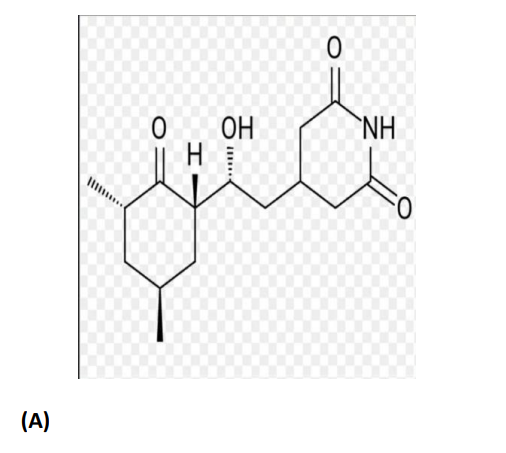
Fig 1: Cycloheximide Structure (A)
Generally, Cycloheximide is an acclaimed inhibitor of protein synthesis but is significantly employed in biomedical research because it stimulates glycogenolysis, gluconeogenesis, and ureogenesis. The protein biosynthesis is inhibited by the Cycloheximide in systems that deploy the ribosomes of 80S type in eukaryotes. It interferes with the translocation step of protein synthesis by binding with 60S ribosomal subunit. The mobilization of the emergent peptide chain and accompanying tRNA from A site to P site on the ribosome happens in the translocation step followed by the incorporation of the next amino acid. Effective stalling of the entire protein synthesis machinery by Cycloheximide due to the hindrance in translocation led to rapid decline in protein production. Studies suggested that the central action of cycloheximide is protein synthesis inhibition but its effects extend beyond this primary function.
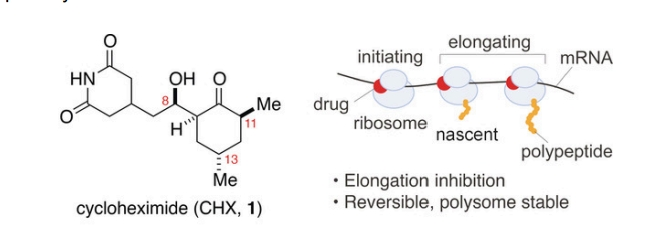
Fig demonstrating cycloheximide that bind the ribosome E-site and its effects on translation
The mitochondrial electron transport might be disrupted by Cycloheximide targeting protein components within organelle and can impact cellular energy production. Cycloheximide can lead to the dysregulation of ion influx and efflux, potentially affecting various signalling pathways due to the inhibition of ion transporter protein synthesis. Profound inhibition (over 86%) of protein synthesis in both cellular and secreted proteins at minimal Cycloheximide concentrations (1 μM) was demonstrated in in vivo studies using radiolabeled leucine incorporation. The effects transpire without compromising membrane integrity as attested by the negligible trypan blue uptake and lactate dehydrogenase release. A fascinating puzzle was unveiled in the in vivo studies regarding Cycloheximide that within 3 minutes of injection, triggers an immediate hyperactive response in the brain. This intriguing effect speculate another faucet to Cycloheximide’s action as this studied effect was independent of protein synthesis. Furthermore, this activity does not explain or justify its amnestic properties, giving hinge on another unidentified mechanism responsible for the memory impairment and still needs to be investigated.
DNA Damage, teratogenesis and other reproductive consequences ( comprising birth defects and toxicity to male germ cells) are the conspicuous toxic effects of Cycloheximide. Cycloheximide is not appropriate or suitable for humans to utilize as a therapeutic compound and is employed mostly for in vitro experiments. Cycloheximide is a renowned tool for its implementation to assess half-life of a protein in the field of molecular biology. It has been shown that the Cycloheximide interferes with deacetylated tRNA by binding the 60S of ribosomal unit to the E-site for the inhibition of translational elongation. Employment of cycloheximide in the agricultural applications as a fungicide is becoming less common and underrated due to its health risks being disclosed and understood. Researchers can employ Cycloheximide for the evaluation of specific protein stability by measuring their detention rates in the visibility of compounds. To elucidate the role of novel synthesized proteins in biological pathways, cycloheximide does play a significant role as described in this blog.
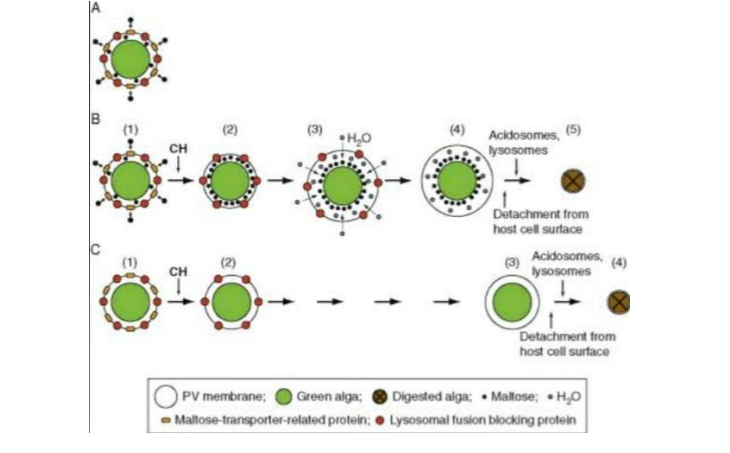
Fig 3: This figure taken from V. Lawana, ... H.M. Mehendale, in Encyclopedia of Toxicology
(Third Edition), 2014 depicts the role of Cycloheximide in protein synthesis
To elucidate the role of novel synthesized proteins in biological pathways, cycloheximide does play a significant role as described in this blog and even has a potential for the emergence of new therapeutics. Mechanism of action and potential use drug targets for various antibacterial and antiviral compounds is identified by Cycloheximide, researchers can gather valuable data for the possible treatment strategies for numerous infectious diseases by analyzing the response of cycloheximide-sensitive organisms to different drugs.
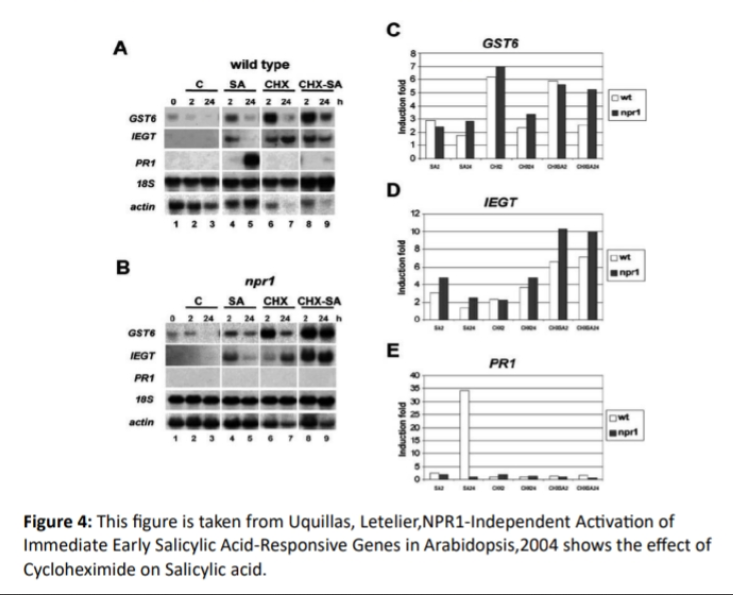
The investigation of protein-turnover and the stimulation and regulation of plant growth and development can be done by the inhibition of protein synthesis in plants, this proves that the cycloheximide has been incorporated into the agriculture field and has induced thought provoking notions elucidating its numerous applications in agriculture sector. By determining the optimal timing for the application of growth regulators, cycloheximide can play its part in helping to improve crop yields and enhancing overall agricultural productivity.
Even with numerous applications, one can't deny cycloheximide inhibitory properties and toxic effects, leading to cellular function disruption and unwanted side effects. When working with this compound, researchers have to meticulously design the experiment by considering appropriate consideration and exposure time. To conclude, In the world of molecular biology, cycloheximide has emerged as an valuable tool by enabling the researchers to delve into the cellular mechanisms and for developing novel therapeutic strategies and is contributing towards scientific advancement. For this purpose this semi-synthetic compound is a key to comprehend the protein inhibition at a deeper level and unlocking its mysteries.





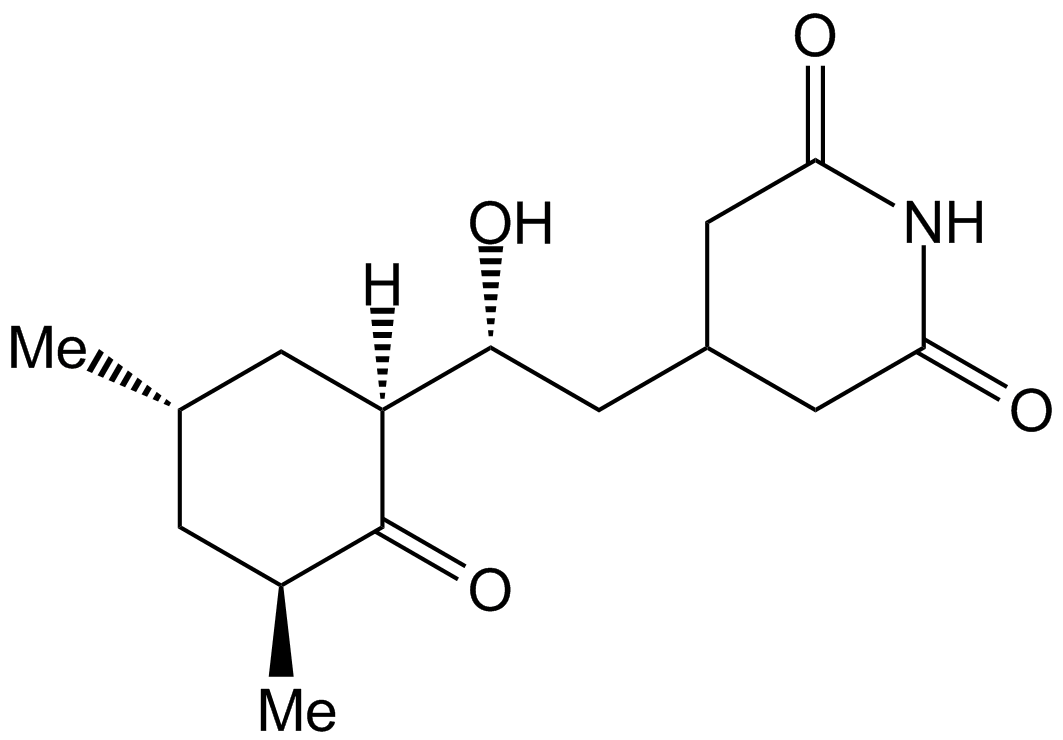








Comments